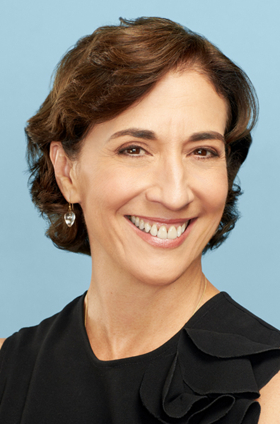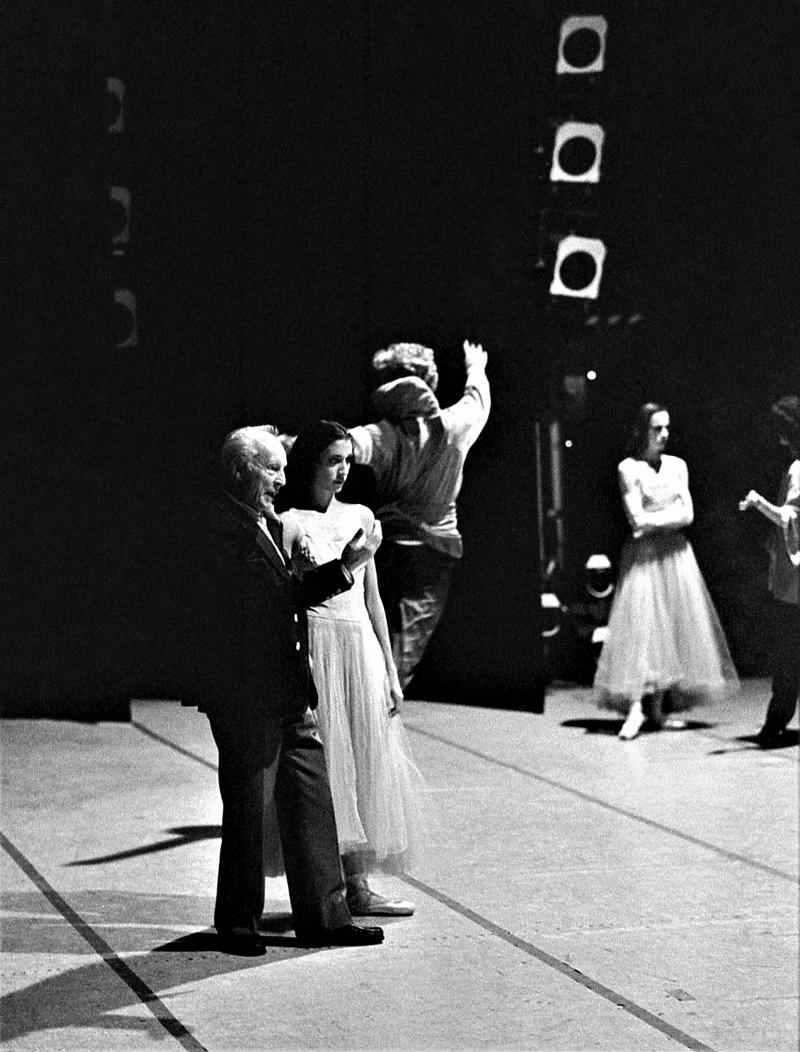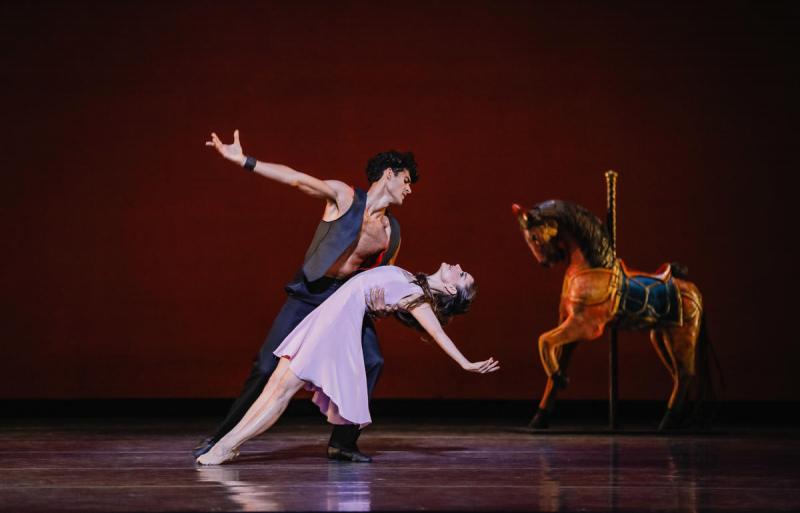Interview: Theatre Life with Lourdes Lopez

Since 2012 today's subject Lourdes Lopez has been living her theatre life as the Artistic Director of Miami City Ballet. The company is performing May 31st through June 2nd at the Kennedy Center as part of Ballet Across America. The May 31st performance is a shared program with Dance Theatre of Harlem who will be performing May 28th through the 30th.
Ms. Lopez has a nearly 40-year career in dance, television, teaching and arts management. As a Soloist and Principal Dancer with New York City Ballet, Lopez danced for two legends of the art form, George Balanchine and Jerome Robbins. Can you imagine being in the same room with those two on a daily basis?
Under the direction of George Balanchine and Jerome Robbins, her star rose quickly at New York City Ballet; In 1984, she was promoted to Soloist, performing countless featured roles including Balanchine's Violin Concerto, Liebeslieder Walzer, Firebird, Serenade, Symphony in C, Agon, The Four Temperaments; and Robbins' Dances at a Gathering, Glass Pieces, Fancy Free, In the Night, Four Seasons and Brandenburg.
Upon her retirement from dancing, Lopez joined WNBC-TV in New York as a Cultural Arts reporter, writing and producing feature segments on the arts, artists and arts education. She was also a full-time senior faculty member and Director of Student Placement, Student Evaluation and Curriculum Planning at New York's Ballet Academy East. She served on the dance faculty of Barnard College and guest taught at numerous dance institutions and festivals in the United States.
In 2002, she became the Executive Director of The George Balanchine Foundation, which works to educate the public about dance and to further the art of ballet, with a special emphasis on the work and achievements of George Balanchine. In this position, she oversaw the 2004 Balanchine Centennial Celebration, a worldwide festival honoring the choreographer and his legacy.
Lopez co-founded The Cuban Artists Fund, which supports Cuban and Cuban-American artists in their endeavors. In 2007 she received an award from the American Immigration Law Foundation honoring Cuban Americans for their accomplishments and contributions to American society.
She also co-founded Morphoses with Christopher Wheeldon in 2007 - a New York-based dance company aiming to revitalize dance through innovative collaborations with important artists from the worlds of music, visual arts, design, film and fashion; and by inviting younger and broader audiences to engage in and actively experience dance.
In 2014 Lopez was elected to serve on the Ford Foundation's Board of Trustees, marking the first time an artist was elected to serve on its board and in 2011, she received the prestigious Jerome Robbins Award for her years in dance. She has also served as a dance panelist for the National Endowment for the Arts.
As if all those accomplishments weren't enough, Ms. Lopez was recently named one of "The Most Influential People in Dance Today" by Dance Magazine.
As you will read, Miami City Ballet has a very diverse program in store for you including two works by Lopez's mentors George Balanchine and Jerome Robbins.
Lourdes Lopez is a true visionary of her craft. Get on over to Kennedy Center and check out Miami City Ballet (and Dance Theatre of Harlem) as part of Ballet Across America to see why she is so revered.
You were born in Havana, Cuba but raised in Miami, Florida. At what age did you come to this country and how long after that did you get interested in dancing?
I came to the US at the age of one and a half years old. I started dancing when I was around six years old, because I was having issues with my feet and legs. I was flat-footed and was having a hard time developing muscles in my legs. I was given corrective orthopedic boots to wear and my mother was told that I needed 'additional strengthening exercises' outside of the PE curriculum to help build muscles. My mother put me in a little ballet class in Miami and I would go two times a week. At the age of eight my corrective shoes came off and my father asked me if I wanted to continue to take ballet classes. He explained it was costly, but if it was something that I liked doing, they would find a way [to pay for it]. I did not miss a beat and immediately responded that I wanted to continue. However, continuing meant that I was then going to be moved to another teacher, Alexander Nigodoff, from the Bolshoi, to start to learn how to dance properly. It was Mr. Nigodoff who opened up the world of ballet to me. He showed me that it was a community. He taught me the names of the steps, how to do them properly and showed me and taught me about ballets such as, Swan Lake, Sleeping Beauty, Coppelia.

Photo by Steven Caras.
What was your first professional job as a dancer?
My first and only job as a professional dancer was with New York City Ballet. I got into the company at the age of sixteen and danced for them for twenty four years, becoming the first Latina principal dancer in the history of that company.

Photo by Steven Caras.
You started out in the corps de ballet at New York City Ballet (NYCB) where you trained and worked under George Balanchine and Jerome Robbins. Can you please tell us about your experiences of working with two titans of the dance? What are some of the greatest lessons you learned from them?
I did start off in the corps de ballet of NYCB. However, my training came from my teacher Martha Mahr in Miami and then from my years at the School of American Ballet. When you got into the company you were trained, but it was Balanchine specifically who taught you how to dance. There is a difference. Balanchine was very specific in class. He was into detail of how a step was executed, the musicality of the step, the speed and clarity of the work. In rehearsals he was interested in seeing you and what you were going to bring to the role.
Jerome Robbins was different. Jerry had a very specific idea of a role and how it should be interpreted. The dancer had to fit his parameters and thoughts, while also finding your own personality and your ability to express yourself. They were literally the complete opposite, so it taught us to be open, flexible and artistically available.
How did you come to Miami City Ballet (MCB)?
The Board Chair at the time called me and asked if I might be interested in the position, in succeeding its founder, Edward Villella. I thought about it and thought that it was an organic move for me. I was raised in Miami; I am completely bi-lingual (thanks to the Miami's public-school system) and the DNA of MCB is the Balanchine aesthetic. It seemed the right move for me. Additionally, I had had experience in being part of the senior faculty at a ballet academy, Ballet Academy East, I had been the executive director for The George Balanchine Foundation, and I had co-founded a contemporary dance company with Christopher Wheeldon, Morphoses. It seemed that I had experienced what was needed to head a ballet company.

Can you please tell us a little something about Miami City Ballet's upcoming appearance at the Kennedy Center?
First, we are so excited! The last time the company was at Kennedy Center was in 2003, so it's been some time and we are thrilled to have been asked back. We are part of the Center's Ballet Across America, and sharing the week with Dance Theatre of Harlem (DTH). The season's engagement showcases companies led by female artistic directors. Each company will present a full program, with a shared celebration uniting both companies on May 31. This shared program will include a world premiere commissioned by the Kennedy Center by Pam Tanowitz, one of the few female choreographers working in dance today, which will be danced by DTH and MCB dancers together. The MCB program will include ballets by Balanchine, Robbins, Twyla Tharp, Justin Peck and Kenneth MacMillan! We are doing Walpurgisnacht (Balanchine), Carousel Pas de Deux (MacMillan), Heatscape (Peck) and Brahms/Handel (Robbins and Tharp).
When you retired from performing you made a career change to cultural arts reporting on TV. Was that a conscious choice to do something totally different from performing?
No, I had never ever truly planned anything after retiring. I only accepted what came my way, thinking that it would eventually lead me somewhere. The on-air arts correspondent position resulted from an arts education program I put together for Casita Maria, a program for underserved communities in the Bronx. I received an award for the work I did and after my remarks I was invited by the general manager of WNBC- Channel 4 to produce arts programming for their on air arts magazine slot.
You were the Executive Director of the George Balanchine Foundation. Can you please tell us what that experience was like?
It was at The George Balanchine Foundation where I learned almost everything, I needed to learn about heading a non-for-profit, and specifically a ballet company. I learned about missions, vision, budgets, governance, board building, donors, fundraising, creating programs, branding, proposals and the importance of contributed revenue versus earned. I owe Barbara Horgan a lot for taking a chance on me and letting me learn, as I went along. I also learned a lot about Mr. Balanchine as an artist, but also as man. In looking through all the research article and archival programs available, it was so interesting how Balanchine programmed. His interest in both entertaining an audience but teaching them at the same time. He truly was a genius, just a master at all aspects of his craft.
What advice would you give to a dancer just starting out in the business?
I would say, say YES to everything that comes your way. Open yourself up to as many experiences as you can and don't limit yourself. Dancers already have the tools to succeed, it's just about applying what they learned in a ballet class, which was discipline, determination, focus, the ability to work with others and the ability to listen to others, to anything new they would now be learning.
Special thanks to Kennedy Center's Press Representative for Ballet/Dance and Education Brittany Laeger for her assistance in coordinating this interview.
Theatre Life logo designed by Kevin Laughon.
Videos


.gif)